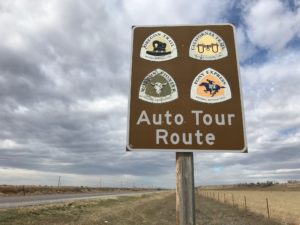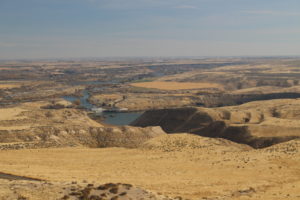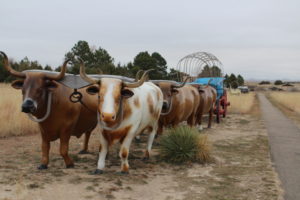 The Trail we hear about most often, and the one we ran across most in our time out west, is the Oregon Trail. People used the Oregon Trail to get to California (California Trail) and to Utah (Mormon Pioneer Trail). But we seem to use the Oregon Trail is our generic name for all the trails west. Just as Route 66 conjures an image of freedom and the open road, the Oregon National Historic Trail conjures an image of emigration and new beginnings.
The Trail we hear about most often, and the one we ran across most in our time out west, is the Oregon Trail. People used the Oregon Trail to get to California (California Trail) and to Utah (Mormon Pioneer Trail). But we seem to use the Oregon Trail is our generic name for all the trails west. Just as Route 66 conjures an image of freedom and the open road, the Oregon National Historic Trail conjures an image of emigration and new beginnings.
The Oregon Trail runs for 2,000 miles from Kansas City, Missouri to Portland, Oregon. The Trail runs through Kansas, Nebraska, Wyoming, Idaho, and Oregon. Today there are many interstates along the Trail. But from 1840 to 1869 the 500,000 emigrants who traveled the Trail considered it the interstate of the day.
Native Americans and fur traders used the paths that constitute the Oregon Trail long before the emigrants began their journeys. Lewis and Clark mapped much of the route. Missionaries followed the fur traders, hoping to convert the “savage heathens.” Once missionaries paved the way, emigrants with their families followed.
The Oregon Territory was shared by Great Britain and the United States from 1818 until 1846. American politicians urged settlers to go out west in order to establish an American presence. The British sold the land in the territory to its citizens, the Americans gave it away for free. Guess who had more citizens in the area in 1846? The Treaty of 1846 between the United States and Great Britain set the boundary of the United States at the 49th parallel except for Vancouver Island. There were also a few disputed islands off the coast of Washington, but I’m sure you already know all about them. The Oregon Trail carried the settlers to these lands west of the Rocky Mountains.

There are 169 historic markers, sites, and trail ruts along the Oregon National Historic Trail. You can see a map with their locations here. Obviously it would take a very long time to see them all. The Auto Tour Route Interpretive Guide is an excellent resource. Oregon Trail Interpretive Centers are located in Oregon, Utah, and Wyoming. Tom and I saw quite a few of the Oregon Trail sites on our travels. You can read about some of them by clicking on these links: Fort Vancouver, Hagerman Fossil Beds, Fort Laramie, and Scotts Bluff.
 I salute the pioneers who headed west in their wagons to begin a new life. They formed the shape of our nation today.
I salute the pioneers who headed west in their wagons to begin a new life. They formed the shape of our nation today.
